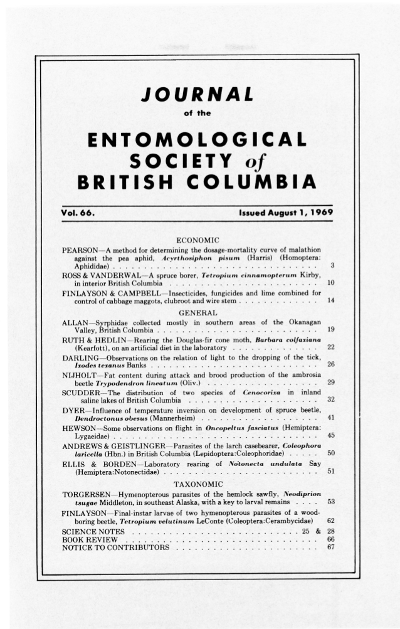Rearing the Douglas-fir cone moth, <i>Barbara colfaxiana</i> (Kearfott), on an artificial diet in the laboratory
Keywords:
Douglas-fir cone moth, <i>Barbara colfaxiana</i>Abstract
The Douglas-fir cone moth, <i>Barbara colfaxiana</i> (Kearfott), can be reared satisfactorily in the laboratory. Methods for handling all stages and rearing larvae on a wheat germ diet are described.References
Barras, S.J. and D.M. Norris, Jr. 1965. In Vitro Establishment and Development of Eucosma sp. Larvae from Cones of Pinus resinosa on an Artificial Nutrient Medium. J. Econ. Ent. 58(5):1033-1034.
Ebel, B.H. 1959. Laboratory rearing of a pine cone insect, Dioryctria abietella (D. and S.). J. Econ. Ent. 52:261-264.
Hedlin, A.F. 1960. On the Life History of the Douglas-fir Cone Moth, Barbara colfaxiana (Kft.) (Lepidoptera: Olethreutidae), and one of its Parasites, Glypta evetriae Cush. (Hymenoptera: Ichneumonidae). Can. Ent. 92:826-834.
Hedlin, A.F. 1965. Rearing Cone Insects in the Laboratory on an Artificial Diet. Can. Dept. of Forestry, Bi-mon. Prog. Rpt. 21(3):4.
Knott, Crawford M., F.R. Lawson, James M. Hobgood, Jr. 1966. Oviposition Cage for the Tobacco Budworm and the Corn Earworm. Jour. Econ. Ent. 59:1290.
McMorran, A. 1965. A Synthetic Diet for the Spruce Budworm Choristoneura fumiferiana (Clem.) (Lepidoptera: Tortricidae) Can. Ent. 97:58-62.
Downloads
Published
Issue
Section
License
Authors who publish with the Journal of the Entomological Society of British Columbia agree to the following terms:
-Authors retain copyright and grant the journal right of first publication with the work simultaneously licensed under a Creative Commons Attribution License that allows others to share the work with an acknowledgement of the work's authorship and initial publication in this journal.
-Authors are able to enter into separate, additional contractual arrangements for the non-exclusive distribution of the journal's published version of the work (e.g., post it to an institutional repository or publish it in a book), with an acknowledgement of its initial publication in this journal.
-Authors are permitted and encouraged to post their work online (e.g., in institutional repositories or on their website) prior to and during the submission process, as it can lead to productive exchanges, as well as earlier and greater citation of published work (See The Effect of Open Access).


